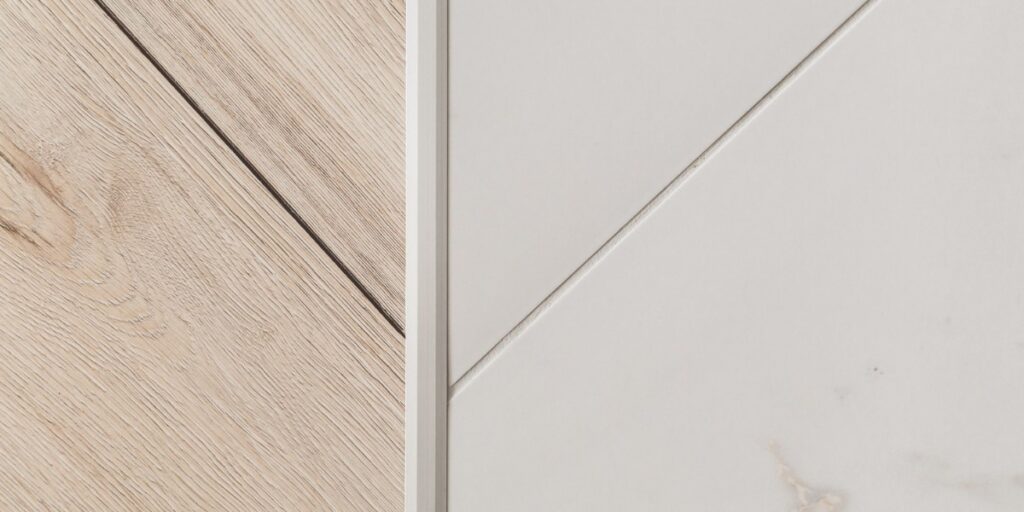When you’re updating your flooring, switching from wood to tile can give your space a fresh, durable look. But what if the two flooring types are not the same height? This is a common issue in both residential and commercial buildings. A wood to tile transition with different heights can create problems if not done correctly. Uneven flooring can look messy, feel uncomfortable, and even be a safety risk.
This guide will help you understand your options for managing uneven floors and creating a clean, professional finish. Whether you’re working on a hotel, office, or retail space, the goal is to keep the floor looking great and feeling smooth underfoot.

Why Wood and Tile Floors Have Different Heights
Before we get into solutions, let’s talk about why this happens.
- Material thickness: Tile is often thicker than wood, especially when you include mortar and grout.
- Underlayment needs: Tile usually needs a cement board or extra prep underneath. Wood may just need a moisture barrier.
- Installation method: Some floors are glued down, some are nailed, and others float above the subfloor. These methods affect the final height.
- Older subfloors: In older buildings, the subfloor may not be level, which adds to the difference in height.
Understanding what’s causing the height difference is the first step to solving it.
Best Ways to Transition Between Wood and Tile Floors
There are several good solutions for a wood to tile transition with different heights. The right one depends on how big the height gap is and where the transition is located.
1. T-Molding
T-molding works well when the two flooring types are almost the same height. It fits between the floors and helps cover the seam. It looks best in doorways or smaller rooms.
2. Reducer Strips
If the tile is higher than the wood, a reducer strip can help ease the drop between the two levels. These strips can be made of wood, vinyl, or metal and provide a smooth slope from one surface to the other.
3. Threshold Pieces
Thresholds are often used in doorways. They sit on top of the two flooring materials and can be custom cut to match the height difference.
4. Ramps
When the difference in height is more than half an inch, a ramp is the safest option. Ramps give people and rolling equipment a gentle slope to travel across. This is especially important in commercial spaces like hotels and medical offices. For more details, check out the ADA flooring guidelines.
5. Saddle Transitions
Saddles sit on top of both floor types and often cover a wider area. They’re useful when the gap is too wide for T-molding or reducer strips.
Choosing the Right Material for Your Transition
Your transition piece should be as strong and attractive as the flooring it connects. Here’s what to look for:
- Durability: Make sure it can handle high traffic, carts, and cleaning equipment.
- Water resistance: Choose a material that won’t absorb water if it’s near a bathroom or kitchen.
- Looks: Try to match the color and style of your floors, or go with something neutral that blends in.
- Ease of maintenance: Pick something easy to clean and repair if needed.
For a deeper look at commercial flooring needs, explore our blog on the top commercial flooring options for high foot traffic.
Special Considerations for Engineered Hardwood to Tile Transition
An engineered hardwood to tile transition can be a little different. Engineered wood is thinner than solid hardwood and often floats above the subfloor.
To make the transition smooth:
- Use a thin underlayment to bring the engineered hardwood closer to the tile height.
- Choose a transition strip designed for floating floors.
- Make sure there’s room for the wood to expand and contract without pushing against the tile.
Since engineered wood reacts more to moisture than tile, use waterproof transition pieces or seal the seams if they’re in wet areas.
Planning for a Seamless Finish
Here are some helpful tips from East Coast Flooring & Interiors to make sure your floor transition turns out well:
- Plan ahead: Always consider transitions when choosing flooring, not after installation has started.
- Match flooring direction: Align wood planks and tile lines for a smoother visual flow.
- Level the subfloor: This makes it easier to reduce the height difference and avoid sharp changes.
- Work with professionals: Commercial projects need expert installers who understand how to avoid gaps and uneven seams.
Where Transitions Usually Happen in Commercial Spaces
In many commercial buildings, transitions appear in common areas like:
- Hotel lobbies
- Office corridors
- Kitchens or breakrooms
- Conference rooms
- Retail entrances
These are high-traffic zones where flooring needs to be both attractive and safe. Using the right transition solution keeps people from tripping and adds a professional look to your space.
A wood to tile transition with different heights may seem like a small detail, but it can have a big impact on the way your space looks and functions. Whether you’re installing engineered wood, porcelain tile, or both, the goal is to make the transition smooth, safe, and visually appealing.
At East Coast Flooring & Interiors, we help property owners and developers across South Florida solve flooring challenges like these every day. Our team understands what it takes to install commercial floors that hold up to heavy use while still looking polished.
Need help planning your flooring transition? Contact East Coast Flooring & Interiors to speak with a flooring expert or schedule a consultation today.